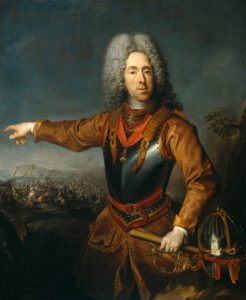The Battle of Nagyharsány in 1687

Disasterous Ottoman defeat at the „second” Battle of Mohács, 12 August 1687. It is referred to it like this because the left wing of the Christian army where the brave Bayern troops stood was only 17 kilometers away from the battlefield of Mohács where Sultan Suleiman had fought that famous battle against King Lajos II of Hungary in 1526.

The troops of the Holy League took Buda Castle in 1686, along with the greater part of the South-Trans-Danubian Region. The Sublime Porte would have liked to ask for peace but Vienna refused it. The Imperial generals were already making preparations for the campaign planned for the following year.

Prince Charles of Lotharingia led the main army southward along the right bank of the Danube river, towards the Bridge of Eszék (Osiek) on the Dráva River. Miksa (Maximilian) Emmanuel was the leader of the troops marching southward between the Danube and the Tisza Rivers’ Region. The units of Louis of Baden, the „Türkenlouis” were among them as well. The two armies joined each other along the Danube River, they had about 50,000 men. There were Austrians, Bayern, Croatian and Hungarian troops alike. As for the Hungarians, their number was about 15,000 men.

The units of Grand Vizier Szári (the Blond) Suleiman were deployed before them at Eszék (Osiek). The Christian Imperial generals realized that it would be a suicide to march along the Bridge of Eszék which was eight kilometers long. That’s why they would have liked to coax the Ottomans out from their well-fortified trenches. Finally, they succeeded in doing so and Suleiman, trusting in the superior numbers of his army (60,000 men), marched out of Eszék and crossed the Dráva River. Then, he began to follow the Imperial troops.

Szári Suleiman sent 8,000 Sipahi cavalry against the left-wing of the Christians that were led by Miksa (Maximilian) Emmanuel. They stood not too far from the battlefield of Mohács that had witnessed a bloody fight in 1526 already.

The troops of the Bavarian prince were repelling easily the too-self-confident Ottomans, although Miksa Emmanuel got wounded in the meanwhile. During this time, the soldiers of Prince Charles were deployed on the slopes of Szársomlyó Hill. At first, he wanted to move towards Siklós castle but Louis of Baden and Miksa Emmanuel were encouraging him to attack. This time, the Grand Vizier sent his Janissaries against the left wing and it solved the question: the Christians had to get engaged in the battle.
When the Anatolian infantry attacked, the cavalry of Arco beat them back.
It was about 5 P.M. when the units of Eugene of Savoy and Jean Louis de Rabutin launched their attack. The Christian army was deployed in three lines, led by two cavalry brigades. When they reached the Turk trenches, the riders waited for the infantry, then attacked the enemy. Eugene of Savoy has particularly distinguished himself by his bravery.

The defenders were soon forced out of the trenches and they marched to take up new positions behind the second line of trenches. Yet, the Ottoman cavalry that was supposed to cover their sides, fled. The Janissaries were abandoned by their cavalry, and most of the 10-12,000 Janissaries were slaughtered by the Imperials.

The confused enemy was forced into the marshland of the Karasica River. Many died there or drowned in the Dráva River. The German cavalry gave no mercy to the runners. On the other side, the Christian riders who had set out from the western part of the army planned to surround the Ottomans but they were too late: the Ottomans could reach the crossing at the Dráva River at Eszék sooner. The Grand Vizier was able to re-organize his army only at Pétervárad Castle.
The Ottomans’ losses are estimated at tens of thousands while Prince Charles lost only 600 men.
On top of that, the Christians’ right wing could not even join the fight because there was a forest that covered them. Almost the entire battle was fought by the left wing. Although the victory was not full because they were unable to take Nándorfehérvár aka Belgrade, the greater part of Slavonia has been liberated.

The Turk garrison of Eger Castle also surrendered and Prince Charles led his men to Transylvania for the winter.
This defeat caused riots in the Ottoman Empire, and the Grand Vizier lost his life in them, too. Sultan IV Mehmed was dethroned and was succeeded by the new Sultan II Suleiman.

As we told it, the Battle of Nagyharsány was just 17 kilometers away from the famous Battle of Mohács as the bird flies, so it is usually referred to as the „Second Battle of Mohács”. Except, that this time it was the Ottomans who suffered a huge defeat.”
Source: Szibler Gábor

You can read my short writing about the Requonqest Wars of Hungary and watch a brief video about them here:
https://www.hungarianottomanwars.com/videos/the-reconquest-wars-of-hungary/
Dear Readers, I can only make this content available through small donations or by selling my books or T-shirts.
If you like my writings, please feel free to support me with a coffee here:
You can check out my books on Amazon or Draft2Digital, they are available in hardcover, paperback, or ebook:
https://www.amazon.com/dp/198020490X
or at https://books2read.com/b/boYd81


My work can also be followed and supported on Patreon: Become a Patron!http://Become a Patron!


https://hungarianottomanwars.myspreadshop.com/

https://hungarianottomanwars.myspreadshop.com/all



